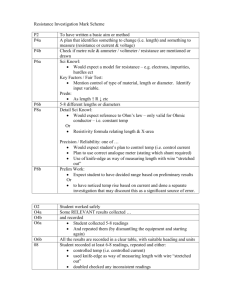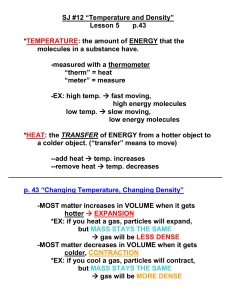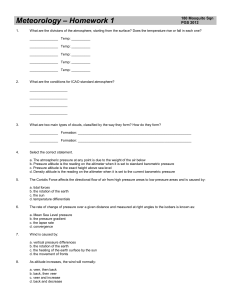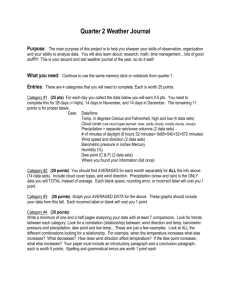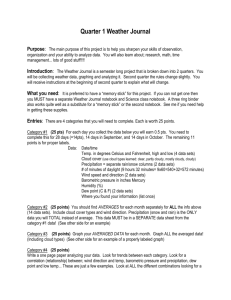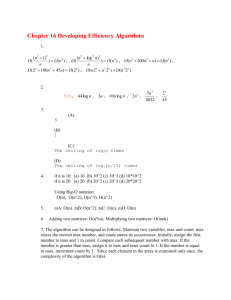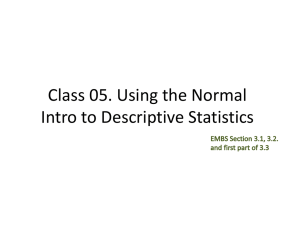Developing an Algorithm:
advertisement
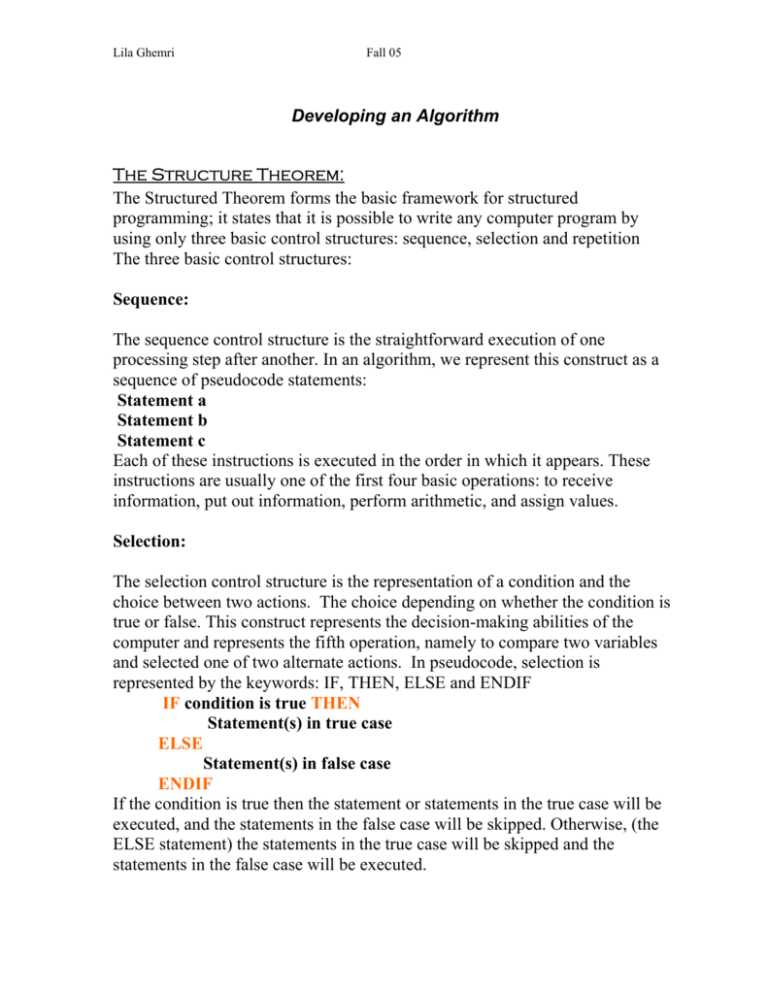
Lila Ghemri Fall 05 Developing an Algorithm The Structure Theorem: The Structured Theorem forms the basic framework for structured programming; it states that it is possible to write any computer program by using only three basic control structures: sequence, selection and repetition The three basic control structures: Sequence: The sequence control structure is the straightforward execution of one processing step after another. In an algorithm, we represent this construct as a sequence of pseudocode statements: Statement a Statement b Statement c Each of these instructions is executed in the order in which it appears. These instructions are usually one of the first four basic operations: to receive information, put out information, perform arithmetic, and assign values. Selection: The selection control structure is the representation of a condition and the choice between two actions. The choice depending on whether the condition is true or false. This construct represents the decision-making abilities of the computer and represents the fifth operation, namely to compare two variables and selected one of two alternate actions. In pseudocode, selection is represented by the keywords: IF, THEN, ELSE and ENDIF IF condition is true THEN Statement(s) in true case ELSE Statement(s) in false case ENDIF If the condition is true then the statement or statements in the true case will be executed, and the statements in the false case will be skipped. Otherwise, (the ELSE statement) the statements in the true case will be skipped and the statements in the false case will be executed. Lila Ghemri Fall 05 In either case, control then passes to the next processing step after the delimiter ENDIF. Example: IF student is part_time THEN Add 1 to part_time_count ELSE Add 1 to full_time_count ENDIF Display part_time_count Display full_time_count A variation of the selection control structure is the null ELSE structure, which is used when a task is performed only if a particular condition is true. The null ELSE construct is written in pseudocode as: IF condition is true THEN Statement(s) in true case ENDIF Example: IF today_temperature greater than 95 THEN Display “ Another hot day” ELSE Display “Have a nice day” Note that there is no keyword ELSE. This construct tests the condition in the IF clause and if it is found to be true, performs the statement or statements listed in the THEN clause. However, if the initial condition is false, no action will be taken and processing will proceed to the next statement after the ENDIF Repetition: The repetition control structure can be defined as the presentation of a set of instructions to be performed repeatedly, as long as a condition is true. The basic idea of repetitive code is that a block of statements is executed again and again, until a terminating condition occurs. It is written in pseudocode as: Lila Ghemri Fall 05 WHILE condition is true, DO Statement block ENDWHILE WHILE loop is a leading decision loop; that is the condition is tested before any statements are executed. If the condition in the WHILE loop is found to be true, the block of statements following the condition is executed once. The delimiter ENDWHILE then triggers a return of control to the retesting of the condition. If the condition is still true, the statement block is repeated, and so the repetition process continues until the condition is no longer true. It is imperative that at least one statement within the statement block can alter the condition and eventually renders it false. Otherwise, the logic may result in an endless loop. Set student_total to 0 WHILE student_total < 50 ⎫ Pr int Student name , address ⎪⎪ ⎬ Statement Block Add 1 to student _ total ⎪ ⎪⎭ Re ad Student Re cord ENDWHILE Points to remember: 1. The variable student_total is initialized before the WHILE condition is executed. 2. As long as the student_total is less than 50 (the WHILE condition is true), the statement block will be executed. 3. Each time the statement block is executed, one instruction within the block will cause the variable student_total to be incremented. 4. After 50 iterations, student_total will equal 50, which causes the WHILE condition to become false and the repetition to cease. Lila Ghemri Fall 05 5. Initialization and subsequent incrementing of the variable tested in the condition is an essential feature of the WHILE construct. Defining the problem: The first step and one of the most important is defining the problem. To help in this initial analysis, the problem is divided into three separate components: 1. Input: a list of the source data provided to the problem. 2. Output: A list of the output required 3. Processing: a list of actions needed to produce the required outputs. When reading the problem statement, you can identify the inputs as the data that is either given or read by the program, and outputs are usually the expected result(s) after processing. Usually, inputs and outputs are expressed as nouns or adjectives. The actions needed for processing are usually specified in the problem statement as verbs. When solving a problem: -Underline all the nouns and adjectives in the problem statement. -Look at the underlined nouns and decide which are inputs and which are outputs. Example: A program is required to read the amount of three bills add them together and print their total Our example would look like: A program is required to read the amount of three bills, add them together and print their total. We use a simple diagram called a defining diagram to put the information: Input Three bills Processing Output total Lila Ghemri Fall 05 Second, underline (in a different color) the verbs and adverbs used in the specification. This will establish the actions required. The sentence should look like this: A program is required to read three bills, add them together and print their total Input Three bills Processing Read, Add, Print Output Total Now that all the nouns and verbs in the specification have been considered and the defining diagram is complete, the problem has been properly defined. That is we now understand the input to the problem, the output to be produced and the processing steps required to convert the input to the output. Selecting Meaningful names: In defining the problem, it is a good idea to introduce unique names, which will be used to represent the variables in the problem and describe the processing steps. All names should be meaningful. A name given to a variable is simply a method of identifying a particular storage location in the computer. The uniqueness of the name will differentiate it from other locations. The name should be transparent enough to adequately describe the variable. When it comes to writing down the processing components of the diagram, we use words that describe the work to be done or action words. These actions describe single specific actions: Read three amounts Add amounts together Print total number Example 2: Find average temperature: Lila Ghemri Fall 05 Write a program that prompts the user for a maximum and a minimum temperature readings on a particular day and calculate and display to the screen the simple average temperature calculated by (maximum temperature + minimum temperature) / 2 First, establish the input and output components: Write a program that prompts the user for a maximum and a minimum temperature readings on a particular day, get those readings, and calculate and display to the screen the simple average temperature calculated by (maximum temperature + minimum temperature) / 2 Input Processing Output Now, establish, the processing steps by underlying the verbs: Write a program that prompts the user for a maximum and a minimum temperature readings on a particular day, get those readings, and calculate and display to the screen the simple average temperature calculated by (maximum temperature + minimum temperature) / 2 The processing verbs are : prompt, get, calculate, and display. By finding the associated objects to these verbs, we specify the defining diagram: Input Processing Output Max_temperature Min_temp Prompt for temperature Get max, min temperatures Calculate average temperature Display average temperature Average_temperature Lila Ghemri Fall 05 At this stage, we are only concerned with the fact that the simple average temperature must be calculated and not how the calculation will be performed. For the following exercises, define the problem by constructing a defining diagram: 1. We require an algorithm that prompts the user for two integers. The program receives the integers and display to the screen their sum, difference, product and quotient. 2. Construct an algorithm that will prompt the user to input three characters, receive those three characters and displays a welcoming message to the screen such as: “Hello xxx! We hope you have a nice day” Designing a solution Algorithm: Designing a solution algorithm is one of the most challenging tasks in the life cycle of a program. Once the problem has been properly defined, we start with a rough sketch of the steps required to solve the problem. - Look at the defining diagram -Using the three structures defined in the theorem (Sequence, Selection and Repetition), attempt to establish how the processing will take place. -This process is a trial and error process, and you will be adding, deleting or altering an instruction or even discarding the solution and starting gain, until you get a working algorithm. IF THE ALGORITHM IS NOT CORRECT, THE PROGRAM NEVER WILL BE. Example 1: Input number_1 number_2 number_3 Processing Read three numbers Add numbers together Print total number Output total This diagram shows what is required, and a simple calculation will establish how. The solution algorithm looks as follows: Lila Ghemri Fall 05 Add_three_numbers Begin Read number_1, number_2, number_3 total = number_1 + number_2 + number_3 Print total END Points to remember: - A name has been given to the algorithm; Add_three_numbers - An END statement at the end of the algorithm indicates that the algorithm is complete. - Each processing step in the defining diagram relates directly to one or more statements in the algorithm. Example 2: A program is required to prompt the user for the maximum and minimum temperature readings on a particular day, accept those readings as integers, and calculate and display to the screen the simple average temperature, calculated by (maximum temperature + minimum temperature) / 2 Defining diagram: Input max_temp Processing Prompt for temperatures Output avg_temp min_temp Get max, min temperature Calculate average temperature Display average temperature Solution algorithm Find_average_temperature Prompt user for max_temp, min_temp Get max_temp, min_temp Lila Ghemri END Fall 05 avg_temp = (max_temp + min_temp) / 2 Output avg_temp to the screen Checking the solution algorithm: After a solution algorithm has been designed, it must be tested for correctness. This step is necessary because most logic errors occur during the development of the algorithm, and if not detected, these errors would be passed on to the program. It is much easier to detect and fix the errors in the pseudocode rather than the corresponding program. Desk checking involves tracing through the logic of the algorithm with some chosen test data. That is, you walk through the logic of the algorithm exactly as a computer would, keeping track of all major variable values on a sheet of paper. • Selecting test data To desk check the algorithm, you need only a few simple test cases, which will follow the major paths of the algorithm logic. • Steps in desk checking an algorithm: There are six simple steps to follow when desk checking an algorithm: 1. Choose simple input test cases that are valid. Two or three are usually sufficient. 2. Establish what the expected result should be for each test case. This is why one should use simple test data. 3. Make a table of the relevant variable names within the algorithm on a piece of paper. 4. Walk the first test case through the algorithm, keeping step-bystep record of the contents of each variable in the table as the data passes through the logic. 5. Repeat the walk-through process using the other test data cases until the algorithm reaches its logical end. 6. check that the expected result established in step 2 matches the actual result developed in Step 5. Lila Ghemri Fall 05 By desk checking an algorithm, we are attempting to detect early errors. Desk check algorithm Example 1 : Add_three_numbers A- Solution algorithm Add_three_numbers Read number_1, number_2, number_3 total = number_1 + number_2 + number_3 Print total END B- Desk Checking i. Choose two sets of input data. The three numbers selected will be 10, 20 and 30 for the first set and 40, 41, and 42 for the second Number_1 Number_2 Number_3 First data set 10 20 30 Second Data set 40 41 42 ii. Establish the expected result for each test case. Expected results: First data set Second data set Total 60 123 iii. Set up a table of relevant variable names, and pass each test data set through the solution algorithm, statement by statement: Add_three_numbers Read number_1, number_2, number_3 total = number_1 + number_2 + number_3 Print total END Lila Ghemri Fall 05 First Pass Second Pass Statement Number_1 Number_2 Number_3 total Read total=… Print 10 10 20 20 30 30 60 Read total=… Print 40 41 42 123 iv. Check that the expected results (60 and 123) match the actual results. v. If at the end of a desk check, the actual results do not match the expected results, the solution algorithm probably contains a logical error. Desk check Algorithm Example Find_average_temperature A- Solution algorithm Find_average_temperature Prompt user for max_temp, min_temp Get max_temp, min_temp avg_temp = (max_temp + min_temp) / 2 Output avg_temp to the screen END (90,80), expected result (85) B- Desk Checking Prompt user Get max_temp, min_temp Avg_temp=-… Max_temp Min_temp 90 80 90 80 Avg_temp 85
